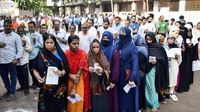On November 6, 2025, as the first phase of the Bihar Assembly elections unfolded across 121 constituencies, India’s democratic machinery found itself at the center of both global admiration and domestic controversy. While the world watched India’s electoral prowess with keen interest—most notably South Africa’s parliamentarians expressing a desire to learn from India’s systems—a storm brewed at home over allegations of voter fraud, with a Brazilian model at the unexpected epicenter.
Chief Election Commissioner (CEC) Gyanesh Kumar was in the thick of action, not just overseeing the massive logistical challenge of polling in Bihar, but also fielding a surprise international call. According to the Election Commission, Mosotho Moepya, Chairperson of South Africa’s Electoral Commission, phoned Kumar to extend his best wishes for what he described as one of the world’s largest democratic exercises. South African lawmakers, the EC confirmed, are set to visit India soon to study its “transparent and efficient electoral system.”
“The Parliamentarians of South Africa want to visit India soon to learn about one of the most transparent and efficient electoral systems in the world,” an EC spokesperson told The Hindu, highlighting India’s growing stature as a model for election management globally. This isn’t a new development—delegations from Nepal, Sri Lanka, Bangladesh, and Mauritius have all previously visited India to observe and learn from its robust polling systems, including the use of Electronic Voting Machines (EVMs), live webcasting from polling booths, and real-time monitoring mechanisms.
Back in Bihar, the numbers were staggering. Over 30 million voters—comprising 19.8 million men, 17.6 million women, and third-gender voters—were casting their ballots on this single day, as reported by Republic World. The total electorate for the multi-phase polls is expected to reach nearly 7.5 crore, spread across 18 districts. High-profile constituencies drew particular attention, including Raghopur (where Tejashwi Yadav of RJD is contesting), Mahua (Tej Pratap Yadav), Tarapur (Deputy CM Samrat Chaudhary), Alinagar (BJP’s Maithili Thakur), Lakhisarai (Deputy CM Vijay Kumar Sinha), Mokama (JDU’s Anant Singh), and Raghunathpur (RJD’s Osama Shahab, son of the late Shahabuddin).
The Election Commission left little to chance, deploying tight security, installing cameras at every polling booth, and ensuring live monitoring through webcasting—a suite of measures designed to maintain transparency and prevent any malpractice. “India’s election management system, including EVMs, live webcasting, and real-time monitoring, attracted keen interest from South Africa,” an official told NDTV. The world was watching, and India was ready to show how it keeps its democracy ticking.
Yet, as India basked in international recognition, a controversy was brewing closer to home—one that would unexpectedly rope in a Brazilian model and spark a fierce political exchange. On November 5, 2025, Congress MP and Leader of Opposition in the Lok Sabha, Rahul Gandhi, held a press conference titled 'H Files,' alleging a widespread voter fraud operation in Haryana. Gandhi claimed that a woman had voted 22 times across 10 different booths using multiple names, and that the image linked to her was actually a stock photograph of a Brazilian model. “That’s a stock photograph, and she is one of 25 lakh such records in Haryana,” Gandhi asserted. He went further, suggesting the operation was centralized and could involve up to 2.5 million records in the state.
The Indian National Congress amplified the issue on social media. “What is a Brazilian Woman Doing on Haryana's Electoral List? Who is this lady? How old is she? Where is she from? She voted 22 times in Haryana, across 10 different booths in the state, using multiple names: Seema, Sweety, Rashmi, etc. This suggests a centralised operation, similar to Aland and Mahadevapura,” the party posted on X (formerly Twitter). The post continued, “What’s shocking is that she's reportedly from Brazil—a Brazilian model, to be specific. She's one of the 25 lakh such records in Haryana, which further supports the existence of a centralised operation. The big question remains: what is a Brazilian woman doing on Haryana's electoral list? There's clearly a reason behind it.”
Larissa, the Brazilian model at the center of this storm, responded with bewilderment. In a video posted to her social media and shared widely by Indian outlets, she said, “My photo was purchased from a stock image platform and used without my involvement. It’s not me, I’ve never even been to India.” She called the situation “crazy,” and described how reporters were suddenly reaching out to her workplace and Instagram, dragging her into a controversy she had no part in. “I have no involvement in Indian politics whatsoever,” she emphasized, underlining the bizarre nature of her sudden fame among Indian voters.
The Election Commission of India (ECI) quickly moved to refute Gandhi’s explosive allegations. In a statement reported by Republic World, the ECI questioned the Congress party’s own role in the polling process: “What were the polling agents of the Indian National Congress party doing in the polling stations? They are supposed to object if the elector has already voted or if the polling agents doubt the identity of the elector... Only 22 election petitions are currently pending in the High Court against 90 assembly seats. Is Rahul Gandhi supporting SSR, which removes duplicate, dead and shifted voters along with verification of citizenship, or is he opposing it?” the Commission asked pointedly.
The ECI went further, challenging the Congress to clarify its position on the Systematic Summary Revision (SSR) process, which is designed to remove duplicate, deceased, and shifted voters from the rolls. “Why were no claims and objections raised by INC’s BLAs during revision to avoid multiple names? Why were no appeals filed by INC’s BLAs during revision to avoid multiple names?” the ECI pressed, suggesting that the party had missed opportunities to address any irregularities through established channels.
The episode highlights the complex and sometimes chaotic nature of Indian democracy—where global admiration for electoral innovation can coexist with fierce domestic disputes over fairness and transparency. On one hand, India’s election management has become a global reference point, with countries like South Africa eager to learn from its experience. On the other, the system faces ongoing scrutiny and political challenges at home, as illustrated by the ‘vote chori’ controversy and the surreal involvement of a Brazilian model who, by her own admission, “never even been to India.”
As the Bihar Assembly elections continue and international delegations prepare to observe India’s polling processes firsthand, the world’s largest democracy remains both a beacon of electoral innovation and a battleground for political accountability. The coming weeks will test not only the strength of India’s institutions, but also the resilience of its democratic spirit—under the watchful eyes of both its citizens and a global audience.

